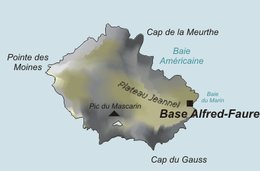geo.wikisort.org - Island
Île de la Possession, or Possession Island, formerly Île de la Prise de Possession, is part of the Subantarctic Crozet Archipelago. Administratively, it is part of the French Southern and Antarctic Lands. It is an important nesting site for seabirds.
Nickname: Possession Island | |
|---|---|
 | |
| Geography | |
| Location | Indian Ocean |
| Coordinates | 46°24′27″S 51°45′27″E |
| Archipelago | Crozet Islands |
| Area | 150 km2 (58 sq mi) |
| Length | 18 km (11.2 mi) |
| Width | 13 km (8.1 mi) |
| Highest elevation | 934 m (3064 ft) |
| Highest point | Pic du Mascarin |
| Administration | |
France | |
| Demographics | |
| Population | No permanent inhabitants; temporary research station staff only |



Description
Île de la Possession lies in the eastern group of the archipelago, about 20 km west of Île de l'Est (East Island). With an area of 150 km2 (58 sq mi) it is the largest island of the group and the only inhabited one. It has a rugged landscape of mountains cut by deep glaciated valleys. The coastal areas and valleys are covered with herbaceous subantarctic vegetation. The island is uninhabited except for the staff of the Alfred Faure research station at the eastern end of the island, with a maximum of about 20 people.[1]
Alfred Faure research station
Alfred Faure research station is a research Station made out of about 12 Main buildings. The Station has about 20 Personnel active at max. It is located on the far eastern point of Île de la Possession. The temperature reaches an average of 5.3°C (41.5°F). The name of the Base comes from Alfred Faure, the leader of the site in the 1960s. The base has a 1.6 KM long Road that connects the base to the sea trough which, a vessel named Marion Dufresne comes very few times a week to bring supplies. An aerial cableway also runs up from the coast to the station.
History
In 1840 the Ross expedition anchored near the island to bring provisions to a stranded group of eleven elephant-seal hunters.
Wildlife
Birds
The island has been identified as an Important Bird Area (IBA) by BirdLife International as a breeding site for seabirds, of which there are at least 26 breeding species. Birds nesting in relatively large numbers include king, northern rockhopper and macaroni penguins, wandering, sooty and light-mantled albatrosses, northern giant petrels, medium-billed prions, Kerguelen and soft-plumaged petrels, and South Georgia diving petrels. Other island breeders in smaller numbers are southern giant petrels, grey-headed albatrosses and Kerguelen terns. Crozet blue-eyed shags, black-faced sheathbills and Eaton's pintails are resident. The smaller birds nest only at higher altitudes because of their vulnerability to rat predation at lower levels.[1]
Other wildlife
The goats that were introduced have been eradicated, though black rats remain and are a threat to the birdlife. Both Antarctic and subantarctic fur seals, as well as southern elephant seals, breed on the island. A pod of about 80 killer whales inhabits the surrounding waters. Two plants and 59 arthropod species endemic to the archipelago are present.[1]
See also
References
- BirdLife International. (2012). Important Bird Areas factsheet: Île de la Possession. Downloaded from http://www.birdlife.org on 2012-01-10.
На других языках
[de] Île de la Possession
Die Île de la Possession (ursprünglich Île de la Prise de Possession) ist die größte Insel der Crozetinseln im südlichen Indischen Ozean. Sie gehört zum französischen Überseeterritorium „Terres australes et antarctiques françaises“.- [en] Île de la Possession
[es] Isla de la Posesión
La Île de la Possession (en español: Isla de la Posesión) es una isla perteneciente al archipiélago de las Islas Crozet, en el océano Índico subantártico. Está administrada por Francia.[fr] Île de la Possession
L'île de la Possession, également appelée île de la prise de Possession, est l'île principale de l'archipel sub-antarctique des îles Crozet, appartenant aux Terres australes et antarctiques françaises.[it] Île de la Possession
L'île de la Possession è l'isola principale dell'arcipelago sub-antartico delle isole Crozet, appartenente alle Terre australi e antartiche francesi.[ru] Поссесьон
Поссесьон — крупнейший остров архипелага Крозе. Входит в состав Французских Южных и Антарктических территорий. Площадь 150 км². На острове работает научная станция, однако постоянного населения нет.Другой контент может иметь иную лицензию. Перед использованием материалов сайта WikiSort.org внимательно изучите правила лицензирования конкретных элементов наполнения сайта.
WikiSort.org - проект по пересортировке и дополнению контента Википедии